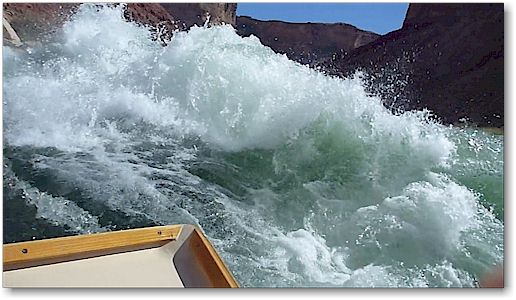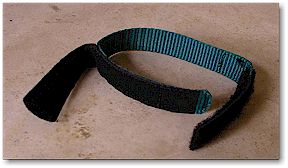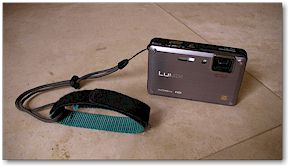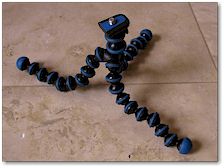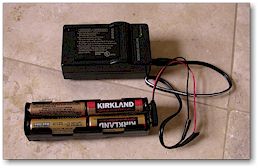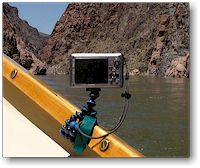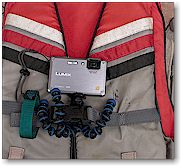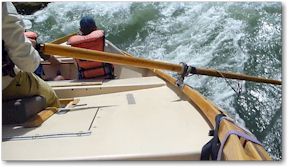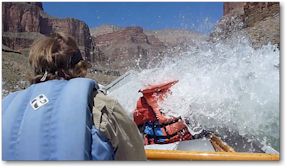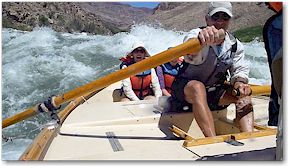Photography Tips
For a River Trip
I don't claim to be a pro but many novices wonder what is the best camera to bring on a trip like this. Well, for picture quality, nothing beats the expensive cameras with interchangeable lenses like the Nikon D90 but I am a fan of the more lightweight point and shoot cameras. At the time (2010) when I researched cameras, I settled on the Panasonic Lumix DMC-TS1. It presently sells for $230 (Amazon), note: TS2 now available. I chose this camera mainly because it is waterproof (to 10 feet), shockproof (drops up to 5 feet) and dust proof. Plus, this 12 megapixel camera has a wide angle 28mm lens and can be set up to take 16:9 format images which show well on an HDTV. It takes standard SDHC cards and I brought three 16 gig cards along for this trip. A 16 gig card will store 2800 (12 mp) stills or about 2 hours of high def movies.
But, more importantly for me was that this camera is able to record high def movies (AVCHD Lite: 720 not 1080, but very good quality) and you can zoom in and out while shooting a movie (many cameras will not do this). I use Sony Vegas Movie Studio HD editing software and am able to put together some very fine movies and, the software allows me to capture still images from the video. The image above is such a frame capture (870X480 max resolution or about 0.5 megapixel - this is fine for DVDs, the web and email but pretty useless for printing - click on image above to see full size).
When you are going through the big name rapids, you will need both hands to hold on. The boatmen take these rapids very seriously and the last thing they want is some yahoo hanging out with one hand on a rail and the other on a camera shooting pictures (might be different on rafts). I was able to push the envelope a bit with a tiny "Joby Gorillapod". It is a small tripod with lego type bendable legs. I discovered it locks in nicely on the slot of the gunnels, fits tightly under the front strap on a life jacket and will even lock into the center hand rails (for facing backward shots). I also found a velcro safety strap that would loop through the existing safety strap. This will allow you to easily protect the camera if the tripod fails (or, you take a swim). Once set up, you turn on the video before the rapid and let it run. When set up on the gunnels, you can point the camera at the occupants, at the boatman, or forward at the rapids. The best shots will be taken from the back end from the raft or dory as you will get the full effect with people, rapids and scenery. If you look at this YouTube movie, you will see us going through Crystal Rapid. The camera is mounted on the gunnels and facing backwards toward the boatman (Allan). I edited in three other shots from different rapids. One at the start (camera on the gunnel, pointed at us), Second looking right at a pour-over and third shot of a wave dousing us (also a gunnel shot).
When mounted on a life jacket, the tripod worked well stuck between the jacket and a clasp but the camera seemed to be too low (for a dory but probably ok in a raft). Ideally, you can figure out some way to move this camera up to a helmet cam type of connection. Turn on the camera, put on the helmet and run the rapid. For movies, it is good to get different angles and perspectives. Even though you will use up precious battery power, I highly recommend when in camp, at least once, you review some of the movies you took and see if you can improve on the camera placement for future shots. Better to notice a problem early and fix it rather than wait until you get home to see all your movies are substandard.
The camera does have a few drawbacks. One, the mic pickup is not very good - you must be right next to a subject to pick up a voice - when doused with water, droplets can sit on the pickup and muffle the audio and, the lens tends to collect water droplets (check and wipe frequently). Another drawback is that when shooting movies, it eats up the battery power. I used the equivalent of 6 batteries on a two week trip. If you choose this camera, you should only use the OEM batteries from Panasonic (Lumix) as the less expensive ones may not work and will not provide as much running time.
But, the OEM batteries are quite expensive (I have only two) so I got around this by making a simple battery charger that I used in the field (see below). Radio Shack sells a battery holder (p/n 270-407) that accommodates eight AA cells (you will also need the 9 volt clip wire assy). With it you will have 12 volts+. I then found a charger for the Panasonic battery that also had a car charger connection. I clipped the cig lighter part off and connected it to the 12 volt AA battery pack (note: maintain plus/minus polarity!). With it I was able to recharge my Panasonic batteries 3 times before a set of AA cells were depleted. Take two sets of fresh AA cells any you have the equivalent of six $30 batteries. This will work for most electronic gadgets with 12 volt chargers.
I can't emphasize enough the importance of a safety strap on your camera. On more than one occasion, the camera broke free from the tripod and was dangling over the side by the strap. The gorrillapod is like a set of legos. The small ball and socket connectors may separate. If this happens, simply snap them back in place.
Below are some images
Velcro strap with over lock - very useful when connecting to life jacket, boat or raft |
Camera shown with strap attached |
Joby Gorillapod with legs bent out (click on image) |
Battery charger - uses 8 AA cells and has a 9v type clip (click image for larger) |
Camera shown connected |
Camera run through top strap |
still captured from video camera on life jacket - click to enlarge |
still captured from video cam on life jacket - click to enlarge |
still captured from video cam on gunnels - click to enlarge |
Return to the River index page.
We opened this web site so that we could share our adventures and travels with you and encourage you to get out there. Please feel free to email us if you have any questions or comments.
